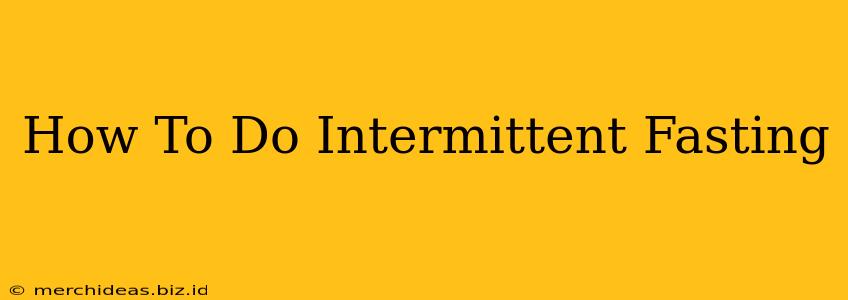Intermittent fasting (IF) has exploded in popularity as a weight loss method, and for good reason. It's a simple yet powerful way to manage your calorie intake and improve your overall health. But before you dive in, it's crucial to understand how to do it safely and effectively. This comprehensive guide will walk you through the basics, different methods, potential benefits, and important considerations.
What is Intermittent Fasting?
Intermittent fasting isn't about what you eat, but when you eat. It cycles between periods of eating and voluntary fasting on a regular schedule. This isn't about starving yourself; rather, it's about strategically timing your meals to optimize your body's natural metabolic processes. During the fasting period, your body taps into stored fat for energy, leading to potential weight loss.
Popular Intermittent Fasting Methods:
Several intermittent fasting methods cater to different lifestyles and preferences. Here are a few of the most common:
1. The 16/8 Method (Leangains):
This is arguably the most popular method. You fast for 16 hours and eat all your meals within an 8-hour window. For example, you might eat between 12 pm and 8 pm, fasting overnight and in the early morning.
Advantages: Relatively easy to adapt to, allows for flexibility in meal timing.
Disadvantages: Might not be suitable for everyone, especially those with demanding schedules.
2. The 5:2 Diet:
This method involves eating normally for five days a week and restricting your calorie intake to around 500-600 calories on two non-consecutive days.
Advantages: Allows for more flexibility in daily eating habits.
Disadvantages: Requires careful planning and calorie tracking on fasting days, might be more challenging to maintain long-term.
3. Alternate-Day Fasting:
This involves fasting every other day. On fasting days, you consume very few or no calories.
Advantages: Can lead to significant weight loss.
Disadvantages: Can be difficult to sustain, may lead to significant hunger and fatigue, and requires careful medical supervision.
4. Eat Stop Eat:
This method involves a 24-hour fast once or twice a week.
Advantages: Simple to understand and follow.
Disadvantages: Requires a significant commitment and might be challenging for beginners.
Potential Benefits of Intermittent Fasting:
Beyond weight loss, intermittent fasting has been linked to several potential health benefits, including:
- Improved insulin sensitivity: This can help regulate blood sugar levels and reduce the risk of type 2 diabetes.
- Reduced inflammation: Chronic inflammation is linked to many diseases. IF may help reduce inflammation markers in the body.
- Cellular repair: Fasting can trigger cellular processes that promote repair and regeneration.
- Brain health: Some studies suggest IF may improve cognitive function.
Important Note: These are potential benefits; more research is needed to confirm them conclusively.
Getting Started with Intermittent Fasting:
1. Consult your doctor: Before starting any new diet, especially if you have underlying health conditions, consult your doctor. They can help determine if intermittent fasting is suitable for you.
2. Start slowly: Don't jump into a strict fasting regimen immediately. Gradually increase the fasting window to avoid adverse effects like fatigue, headaches, or irritability.
3. Stay hydrated: Drink plenty of water, unsweetened tea, or black coffee during your fasting periods.
4. Choose a method that suits you: Select a method that aligns with your lifestyle and preferences. The 16/8 method is a great starting point for many.
5. Listen to your body: Pay attention to your hunger cues and adjust your fasting schedule accordingly. If you feel overly hungry or unwell, stop and eat.
6. Focus on nutrient-dense foods: During your eating window, prioritize whole, unprocessed foods, such as fruits, vegetables, lean proteins, and healthy fats.
7. Be patient and consistent: Results take time. Don't get discouraged if you don't see immediate changes. Consistency is key to achieving your goals.
Potential Side Effects of Intermittent Fasting:
While generally safe for many, intermittent fasting can cause some side effects, especially in the beginning:
- Hunger: Initially, you might experience intense hunger.
- Headaches: Some people experience headaches during the fasting period.
- Fatigue: Feeling tired is common, especially in the early stages.
- Irritability: Mood swings can occur due to changes in blood sugar levels.
- Constipation: Some people experience digestive issues.
These side effects are usually temporary and resolve as your body adapts.
Is Intermittent Fasting Right For You?
Intermittent fasting can be a powerful tool for weight loss and improved health for many individuals, but it is not a one-size-fits-all solution. If you have any underlying health conditions, it's crucial to consult your doctor before starting an intermittent fasting regimen. Remember that a balanced diet and regular exercise are still essential components of a healthy lifestyle, and intermittent fasting should be used as a supportive tool, not a replacement for these fundamentals. Consider your lifestyle, consult your healthcare professional, and then decide if intermittent fasting is the right approach for you.
